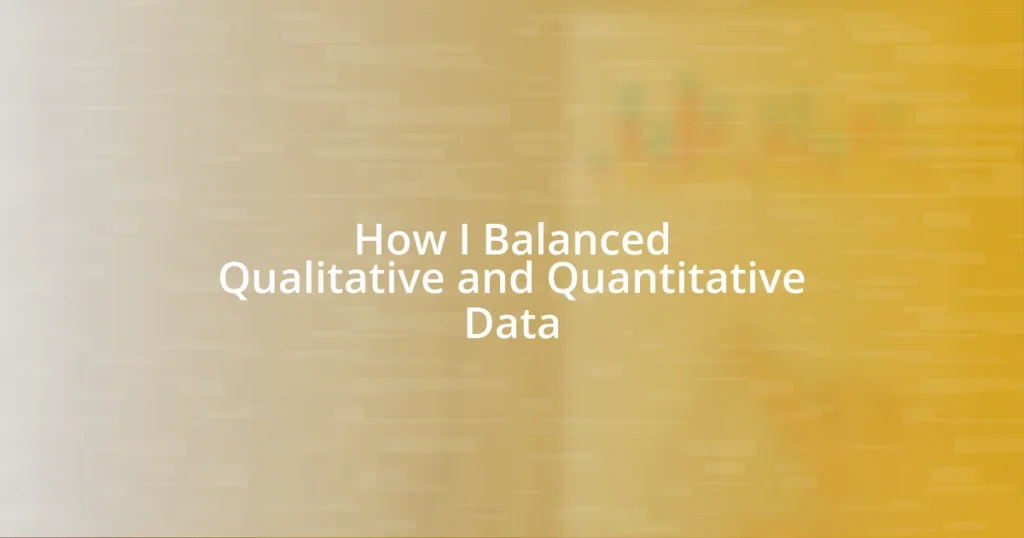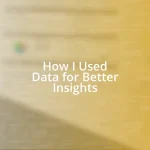Key takeaways:
- Qualitative data uncovers the emotional and contextual stories behind numbers, enriching insights and decision-making.
- Balanced analysis of both qualitative and quantitative data leads to a comprehensive understanding of complex issues, preventing skewed interpretations.
- Integrating both data types reveals hidden trends and emotional connections, fostering a deeper engagement with the audience and guiding impactful decisions.

Understanding Qualitative and Quantitative Data
Understanding qualitative and quantitative data is like recognizing the different languages of human experience. Quantitative data speaks in numbers, offering measurable insights that are great for spotting trends—think of a time when you were crunching figures to justify a business decision. On the other hand, qualitative data dives into the deeper, often unquantifiable aspects of what people feel and think, revealing the stories behind those numbers.
During a recent project, I found myself immersed in both data types. While analyzing survey results filled with quantitative data, I stumbled upon qualitative comments that made me pause. They were candid and raw, sharing frustrations and aspirations that the hard numbers alone couldn’t convey. Isn’t it interesting how often the emotion behind the data gets lost if we focus solely on metrics?
When I reflect on my experiences, I realize that the most profound insights often come from juxtaposing both data forms. I remember using focus groups to complement my statistical analyses, which illuminated perspectives that I hadn’t considered. How often do we miss the nuances because we’re too focused on formulas? The magic happens when we blend the tangible with the intangible, creating a richer narrative from the data we gather.

Importance of Balanced Analysis
Balanced analysis is crucial because it enables a comprehensive understanding of complex issues. I recall working on a project where the qualitative data highlighted customer frustrations that the numbers alone didn’t show. By appreciating this emotional layer, we were able to revise our strategy, strengthening customer loyalty.
Moreover, relying solely on one type of data can lead to skewed interpretations. I remember an instance where I prioritized survey metrics and overlooked feedback comments. The end result was a solution that satisfied the numbers but failed to resonate with people’s real experiences. This taught me that blending insights enriches the narrative and enhances decision-making.
When I reflect on the ultimate value of balanced analysis, it’s evident that both qualitative and quantitative data serve unique purposes. They complement and challenge one another, creating a fuller picture. A vivid example is when I merged user engagement statistics with testimonials—suddenly, I could visualize user journeys and narrative arcs, giving life to otherwise sterile data.
| Data Type | Characteristics |
|---|---|
| Quantitative | Measured in numbers, easy to analyze, shows trends |
| Qualitative | Descriptive, provides context, captures emotions |

Methods for Collecting Qualitative Data
Capturing qualitative data can take on many forms, and each method has its unique strengths. I’ve found that in-depth interviews often provide some of the richest insights. During a recent project, I sat down with participants one-on-one, creating a warm environment that encouraged them to share their stories freely. Their narratives revealed not just opinions, but emotional layers that filled in gaps I didn’t even know existed.
Here are some methods I’ve employed to gather qualitative data effectively:
- In-depth Interviews: Engage participants in one-on-one discussions to dive deeply into their thoughts and experiences.
- Focus Groups: Bring together diverse individuals to discuss a topic, allowing interaction and a breadth of perspectives.
- Observations: Immerse yourself in a setting to gain insights into behaviors and attitudes, often unveiling unarticulated needs.
- Open-ended Survey Questions: Allow respondents to express their thoughts freely, offering richer qualitative data alongside quantitative metrics.
Each of these methods reveals distinct aspects of human experience. When I conduct focus groups, for instance, I often witness participants building on each other’s ideas, creating a dynamic dialogue that surfaces insights I could never acquire through surveys alone. It’s in these moments that I truly appreciate the power of qualitative data—the voices behind the metrics.

Techniques for Quantitative Data Collection
Collecting quantitative data is a meticulous process that typically relies on structured approaches to ensure accuracy and reliability. One popular technique is the use of surveys, which I find incredibly valuable. In a recent market research project, I crafted a structured survey that allowed me to collect numerical data on customer preferences. I was amazed at how quickly I could gather insights on trends that might have otherwise been missed with less structured methods.
Another effective method I’ve used is the implementation of experiments or A/B testing. This hands-on approach allows you to compare two or more variations of a product or service to see which performs better with users. During an online campaign, I split test different ad copies, measuring conversion rates. It was eye-opening to see how a single word change could significantly impact our results. What have you tested lately that’s opened your eyes to new possibilities?
Additionally, observational studies provide substantial quantitative insights when direct interaction isn’t feasible. Recently, I spent time observing user interactions on our website through analytic tools. Watching where users clicked and how they navigated offered a wealth of measurable data—metrics that told a story far clearer than any words alone could convey. Isn’t it fascinating how numbers can reveal patterns in human behavior that we might overlook?

Integrating Both Data Types
When I set out to integrate qualitative and quantitative data, I often think of them as two pieces of a puzzle that together create a comprehensive picture. One memorable project involved launching a new product, where I combined customer feedback from interviews with numerical data gathered from surveys. This blend allowed me to understand not just what features were popular, but also the emotional connections customers had with those features. Isn’t it intriguing to see how numbers can validate heartfelt stories?
In another instance, I conducted A/B testing alongside focus group discussions. The A/B tests provided concrete data on which design variant performed better, while the focus groups unveiled the “why” behind those preferences. I remember one participant vividly expressing her frustration with a color scheme, which the data had flagged as less favorable. It was a blend of statistics and personal sentiments that led to a design we were truly proud of. Can you imagine how much richer our understanding is when we merge these methodologies?
Ultimately, I’ve learned that integrating both data types doesn’t just enhance insights but fosters a deeper connection to the audience. I once analyzed qualitative feedback from a community event and paired it with attendance figures. The data revealed a surprising trend—while numbers indicated high turnout, many attendees felt disconnected from the experience. This pushed me to rethink future events, ensuring they resonate with our audience on both emotional and practical levels. How can you use this integration to better engage with your stakeholders?

Analyzing the Combined Data
Once I sat down to analyze combined qualitative and quantitative data from a recent customer feedback initiative, I discovered that the richness of people’s experiences often painted a different picture than the numbers suggested. For instance, while the surveys indicated a high level of satisfaction, reading through the open-ended responses revealed a subtle undercurrent of frustration about our customer support. Isn’t it interesting how the data can surface hidden emotions that numbers alone can’t capture?
In my experience, combining both data types can illuminate the nuances that drive our decisions. During one project, my team and I delved into user behavior reports and cross-referenced them with interviews from our target demographic. This allowed us to connect the dots: while our analytics showed users abandoning the checkout page, the interviews exposed anxieties about security. Has anyone else felt that disconnect between what the data shows and what people feel?
The deeper I go into this analysis, the more I realize it’s not just about identifying trends but about understanding why those trends exist. For example, when I integrated insights from sentiment analysis tools with sales figures, an unexpected narrative emerged: we saw spikes in sales tied to specific social media posts, but the qualitative feedback revealed that people were actually responding to our brand’s personality rather than a particular product. How often do we pause to think about the stories our data tells?

Practical Applications and Case Studies
I remember working on a community outreach project where we aimed to improve engagement. We utilized community surveys for quantitative data; participation numbers were promising. Yet, when I delved into the qualitative aspects—like comments from local forums—I discovered a significant portion felt unheard in decision-making processes. Isn’t it fascinating how the numbers might suggest success, but the stories tell a different tale?
In a marketing campaign I led, I employed both focus group feedback and web analytics to evaluate our messaging. The analytics revealed a surge in clicks, but the focus groups shared a profound emotional disconnect – many felt the campaign didn’t reflect their values. This dichotomy sparked a pivotal shift in our strategy! It’s remarkable how balancing the numerical and narrative can lead to a richer understanding of what truly resonates with audiences.
Another instance was when I analyzed the effectiveness of a workshop. Initial quantitative feedback from rating scales looked stellar, but the written comments hinted at a sense of monotony in the delivery. By merging these insights, we revamped our approach, introducing interactive elements that transformed future sessions. I often think, how crucial is it to really listen to both the numbers and the narratives they accompany? They hold the potential to guide us toward more impactful decisions.















